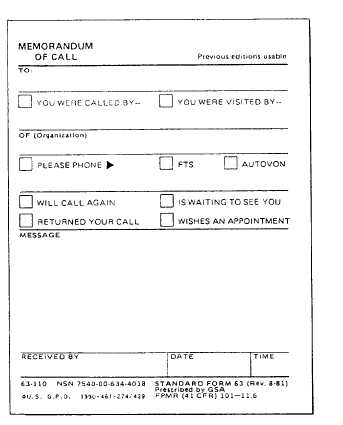. Be sure your telephone conversations always
demonstrate courtesy, tact and good judgment.
TAKING MESSAGES
When the person called is unavailable, offer to take
a message. The memorandum of call (figure 1-16)
contains several blocks of information to assist you in
recording a message. USE THEM! Gather as much
information as possible so the person who was called
does not have to reconstruct the entire conversation with
you. Also, do not be lazy and scribble the message so
that it can only be deciphered by a handwriting
specialist.
Even if a message is not given, make a note of the
call. As soon as you hang up, place your note where the
person for whom it is intended is sure to receive it.
ANSWERING/FACSIMILE MACHINES
Only a few years ago, answering and facsimile (fax)
machines were considered luxury items. Today, you
would be hard pressed to find an excuse not to have them
in your office.
Figure 1-16.—Memorandum of Call.
The answering machine offers many benefits.
During nonworking hours or when training is in
progress, the answering machine can be activated and
you will not miss a call. Some state-of-the-art models
can even give you the date and time of the incoming call.
Fax machines allow you to send or receive a
document from an office across the street or across an
ocean. If your office has more than one telephone line,
you can connect the answering machine to one and the
fax machine to the other, providing total office coverage
after hours. Fax machines come in handy when
disseminating a short fuse news release to the media or
when sending releases and correspondence to other
public affairs offices.
BUDGETING TIME
There are some days when the telephone will
seemingly “ring off the hook” and you spend half a day
taking care of business on the telephone. This is
permissible if your projects do not suffer in the process.
Do not be a slave to your telephone. If you have
several projects on the front burner and the telephone
continually rings, the priority rests with your office
work. Make sure messages are taken
returned at the earliest possible moment.
SHIPBOARD PUBLIC AFFAIRS
MANAGEMENT
and calls are
OFFICE
Learning Objective: Outline the proper arrangement of
a shipboard public affairs office in terms of office
arrangement, manning, facilitating special projects
and financial planning.
Managing a shipboard public affairs office
incorporates all of the topics you have read about so far
in this chapter, but it also includes a few other unique
aspects you should realize. Manning concerns and
special projects will be discussed in this section.
TYPICAL OFFICE ARRANGEMENT
A large public affairs office afloat normally includes
a full-time (1650) or collateral duty PAO, a senior
journalist (JO1, JOC, JOCS or JOCM) and a staff
comprised of a mixture of JO2s, JO3s and JOSNs.
Manning configurations vary from ship to ship.
The staff handles more than just public affairs work.
As the senior journalist and overall manager, you must
make assignments to cover the closed circuit television
1-41


